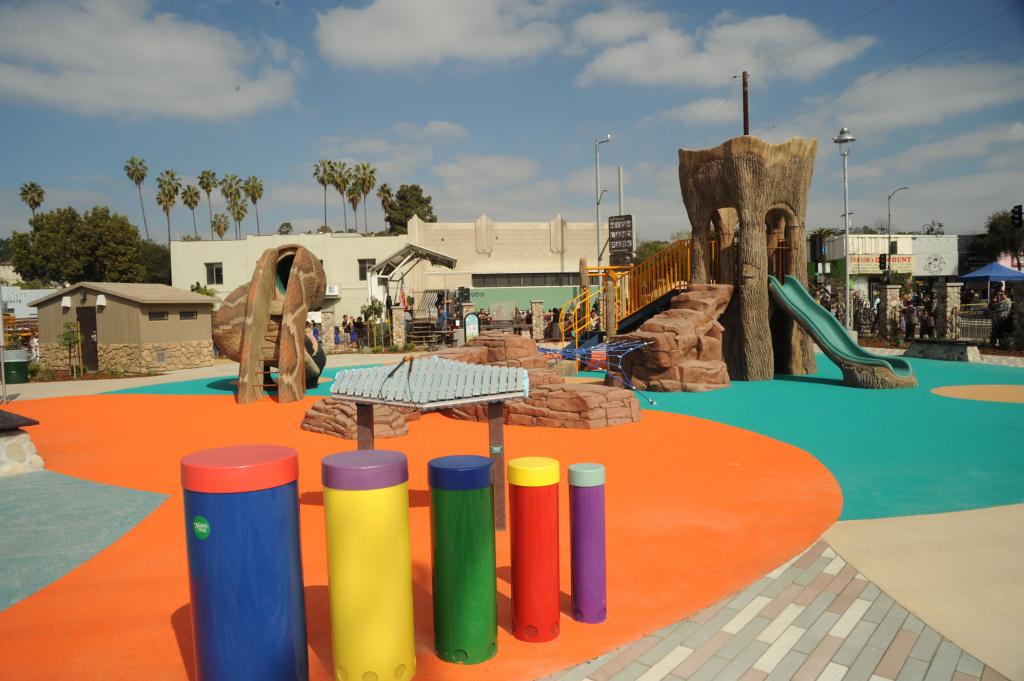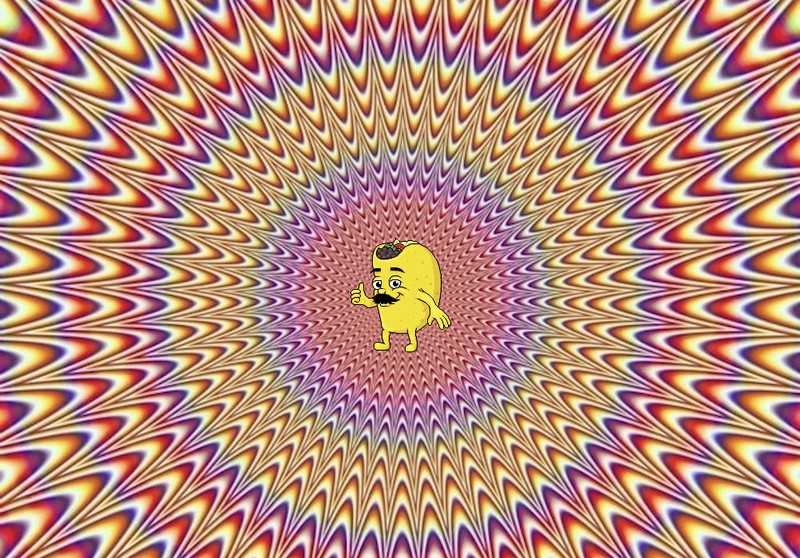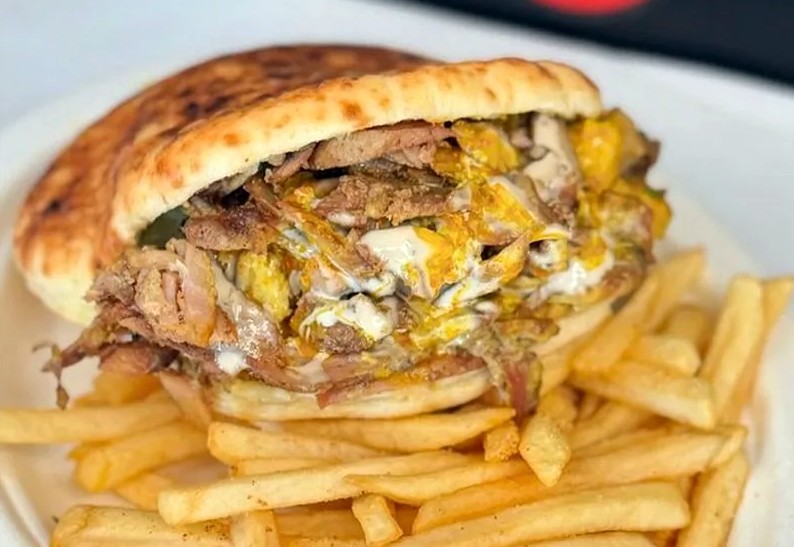Longtime Highland Park Residents Remain Skeptical of York Park’s Safety After More Than 800 Gallons of Fuel Leaked Into the Soil It Was Built Over In the 80s and 90s

When Saúl Narro was a little boy, he used to ride his bike through a gas station owned by a friend’s relative. Decades later, the gas station is gone, replaced by a playground. But the lifelong Highland Park resident won’t go anywhere near York Park, and Narro said his neighbors avoid it, too.
Longtime residents worry about possible contamination and point to how the now-park had a history of gasoline leaks that were reported to have contaminated the groundwater and soil in the 1980s and 1990s.
Narro, a neighborhood historian who self-identifies as being “born, baptized, and raised” in Highland Park, said, “you don't hang out in that area, especially at the park.”
York Park is a small park with a fanciful playground, a slide coming out of an enormous fake tree trunk, and a jungle gym decorated to look like a snake. Families frequent the park, and many folks come for the birria truck parked right out front that stays open late into the night.
There’s no trace of the park’s former life as a gas station. Newcomers to Highland Park wouldn’t necessarily know that hundreds of gallons of fuel once leaked into the ground beneath the elaborate playground. The floor of the playground area is covered in rubber surfacing, but the edges of the park are landscaped with plants and wood mulch. The soil is potentially just inches away from a curious crawling child who might unwittingly put the dirt into their mouth.
York Park has become a flashpoint over environmental safety in the neighborhood. Earlier this year, the Historic Highland Park Neighborhood Council (HHPNC) called for more testing of the site and a full environmental assessment. At one neighborhood council meeting about the park, residents argued over whether more testing and remediation was worth taxpayer dollars.
***
Years of papers documenting the history of York Park live at the offices of the Los Angeles Regional Water Quality Control Board (LARWQCB) in downtown Los Angeles. Many of the documents were shared with L.A. TACO and Neon Hum by Mando Medina, a lifelong resident of Highland Park who’s an anti-gentrification activist behind the Instagram account @highland_park_nela on Instagram. Medina has been one of the loudest voices in the neighborhood, raising the alarm about York Park.
There are reports about the contamination and plans to fix the contamination in the documents he retrieved. The timeline is jumbled with multiple rounds of spills and cleanups and requests for clarifications about the cleanups. Much of it is from two decades ago, and the documents are hard to parse without a geology degree.
Here’s what we know: the first gasoline leak was in 1981—approximately 800 gallons leaked due to a broken fuel line. Shell extracted 610 gallons of “free-floating gasoline product” from the site throughout 1982. Then, in 1985, Shell notified the previous owners of the station that groundwater observation wells showed evidence of gasoline in the groundwater, which is a concern because it can potentially mean the contamination could seep into drinking water. At the time, in a contractor report, Shell admitted that “significant amounts of fuel could be present in the site’s soils.”
The second leak happened in 1992. The new owners of the gas station reported a leak of diesel fuel due to a piping failure. The amount of diesel fuel released is unknown. Two evaluations—in 1996 and 1997—both found gasoline and gasoline byproducts in tests of the groundwater observation wells.
One contractor concluded that gasoline, used oil sludge, and diesel had contaminated soil from five to 12 feet deep throughout the property. A separate test of the groundwater, 19 to 21 feet deep, was also contaminated.
The contamination was a concern, in part, because exposure to petroleum products is linked to serious health issues. An article about York Park published by The Occidental earlier this year noted that, according to federal health authorities, exposure to the chemicals that make up petroleum and crude oil “can affect the human central nervous system, and could potentially affect the blood, immune system, liver, spleen, kidneys, lungs and, for pregnant people, developing fetuses.”
The landscape architect is quoted as saying “that the property still has significant environmental hazards and that his organization was currently in the data collection phase of an environmental study.”
“The same profile stated that … benzene, another chemical present in the soil after the 1992 spill, causes cancer in humans, and long-term exposure to high levels of benzene in the air can cause leukemia,” the article said.
Two decades passed after the second leak. The gas station shut down, and the lot remained vacant. And then, as the gentrification of Highland Park accelerated, the office of council member Jose Huizar made plans to revitalize the lot where the gas station had once been.
In a video about the groundbreaking at York Park, Huizar said the park was part of a plan to re-envision York Boulevard. “Today’s a great day,” he said. “This has been a long time coming.”
Huizar’s office hired a landscape architect to redevelop the site, according to an article published in June 2011 in Patch. The landscape architect is quoted as saying “that the property still has significant environmental hazards and that his organization was currently in the data collection phase of an environmental study.”
Five days later, Patch published another article, based on a LARWQCB report that found the site “does not pose a threat to the public … despite trace elements of gasoline remaining in the soil.” The same landscape architect is quoted in that article, saying that his company “will go above and beyond the law in further mitigating environmental concerns in the park’s construction.”
That report, published by the LARWQCB in February 2011, said the site was low risk to develop, based on multiple remediations that had been done since the first spill in 1981.
The report said that there had been close to 5,000 tons of soil removed and 610 gallons of gasoline. It also noted that although a gasoline additive had consistently shown up in tests of one of the groundwater monitoring wells, the site should still be considered “low-risk” because none of the other wells had shown the presence of that chemical. It was deemed unlikely that the regional groundwater supply would be contaminated.
But some neighborhood residents cast doubt on what’s reported in those official papers.
Narro saw a few trucks come to take the soil out of the site when it was being cleaned. But he said the amount removed didn’t seem to be enough soil to cover more than just the top layer.
“I didn't see that many trucks that it would take to take all that (contaminated soil), so that's kind of sketchy,” said Narro.
Earlier this year, the local neighborhood council (HHPNC) released a community impact statement asking for additional testing and a full environmental site assessment, authorized and funded by the city.
Melanie Malone, a geologist and assistant professor at the University of Washington Bothell, pointed out that just because a certain level of contamination is considered acceptable doesn’t necessarily mean it’s safe. “I understand why members of the community might want to do the test,” she said.
The statement pointed out that one of the companies responsible for removing the diesel fuel from the soil was “believed … [to be] a bad actor” and was later sued by California for improper disposal of hazardous waste.
In its community impact statement, the HHPNC also reported that they’d done their own test of the surface soil at York Park and found trace levels of diesel – 11.3 mg/kg – below the threshold for contamination established by authorities. But for residents like Medina, the test results were evidence that more testing was warranted.
“There should be [no diesel] tested at all at that level,” Medina said. “So that means that there should be a lot detected at five feet because of the detection of the diesel at a couple of inches.”
Medina isn’t a soil contamination expert, but L.A. TACO and Neon Hum reached out to a couple to see what they thought.
We spoke to a geologist and an engineer about York Park and some residents’ fears of contamination there. They had differing opinions about whether trace levels of diesel in the upper levels of the soil were likely to mean that there was a greater level of contamination lower down. But both agreed that they understood why residents might want further testing.
Melanie Malone, a geologist and assistant professor at the University of Washington Bothell, pointed out that just because a certain level of contamination is considered acceptable doesn’t necessarily mean it’s safe. “I understand why members of the community might want to do the test,” she said.
The other expert was more blunt in his assessment.
“I wouldn’t let my kid play on that playground,” said Felipe De Barros, an associate professor in civil engineering at USC who studies groundwater.
Residents of CD 14 have good reason to be on edge about environmental threats to their health and safety. Some residents in the district were impacted by one of the biggest environmental disasters in California in recent memory. A now-defunct battery recycling plant poured lead dust into the air of the district’s southern edge for decades.
The plant was run by Exide Technologies, which operated on a temporary permit provided by the California Department of Toxic Substance Control. Exide closed in 2015 after years of residents protesting and ringing alarm bells about abnormally high rates of cancer and other health issues in their neighborhoods nearby the plant.
But the question of testing the soil at York Park has become a divisive issue in the neighborhood. At one neighborhood council meeting following the release of the community impact statement, things got heated.
After Exide, residents don’t necessarily believe that they can depend on people in power to identify and protect them from environmental threats to their health.
But the question of testing the soil at York Park has become a divisive issue in the neighborhood. At one neighborhood council meeting following the release of the community impact statement, things got heated.
One resident who identified herself as Lisa objected to any further testing, saying, “You would be wasting resources based on not a valid present reason for spending my taxpayer dollars because you're asking to have testing to make you feel comfortable. I don't see that as a compelling reason.”
Another resident, who said his name was Mario, responded: “Long story short, basically what I'm saying is that I think it's best to test it no matter what. I mean, everybody is worried about tax taxpayer dollars, whereas we pay for the dumbest things, and you're worried about taxpayer dollars here for a test that is going to make sure that people are safe.”
Following the neighborhood council’s community impact statement, CD 14 council member Kevin de Leon released his own letter, saying, “RAP [Recreation and Parks] informed my staff that they were sufficiently certain that the site was safe based on their internal documents and those from the LARWQCB and that the safe levels of chemicals associated with diesel fuel detected by the community member were not sufficiently high for RAP to initiate an additional ESA [Environmental Site Assessment] at this time.”
The neighborhood council has since backed down, saying they “still do want the testing done” but felt they “had taken it as far as we could possibly take it.”
“The organizations who make those final testing decisions ... convinced us that even though low risk is not risk, it was remediated within the legal limits,” neighborhood council board member Emily Spokes wrote in response to emailed questions by L.A. TACO and Neon Hum. “However, we hope to pass the baton onto the next person in this relay.”
That may mean passing the baton to Medina and others who remain unconvinced the park is safe. Medina and other concerned residents have since tried to crowdfund the money to test the soil. Last week, they launched a private and offline fundraising campaign to raise the $8,000 necessary to dig deep into the soil and test it for diesel. The campaign has, as yet, raised $2,000.
“I was hoping for peace of mind. I was like, if you do the test, that if you find out, there's nothing there or if it's safe and find out. I'll leave it at that,” said Narro.
This article was published in collaboration with Neon Hum. If you are interested to see how redistricting led to Jose Huizar’s corruption charges, check out episode 5 of ‘The Sellout.’
Stay in touch
Sign up for our free newsletter
More from L.A. TACO
How Your Business Can Benefit From Sponsoring L.A. TACO
When your company sponsors L.A. TACO, you receive a variety of quick and cost-effective benefits for far less than what we price our traditional advertisements and social media mentions at.
Juárez-Style Burritos Have Arrived in Southern California, And They are Already Selling Out In Less than An Hour
The month-old strip mall taquería in Anaheim make all their flour tortillas from scratch using both lard and butter, resulting in an extremely tender vehicle for their juicy guisados like carne en su jugo, carne deshebrada, chile colorado, chile relleno, and chicharrón. Every tortilla is cooked to order, too.
Urgent: L.A. TACO Falling Short of Fundraising Goals and Needs Your Support
Emergency. This is not a test. This is not a ruse. This is not a marketing scheme. We need your support if we're going to make it and every single membership counts.
What To Eat In L.A. This Weekend: Mexican-Style Pastrami, ‘Trashburgers,’ and Flamin’ Jim Morrisons
Plus, a new shawarma spot in Tarzana and the country's first wine festival dedicated solely to orange "skin contact" wine happening in Hollywood.




